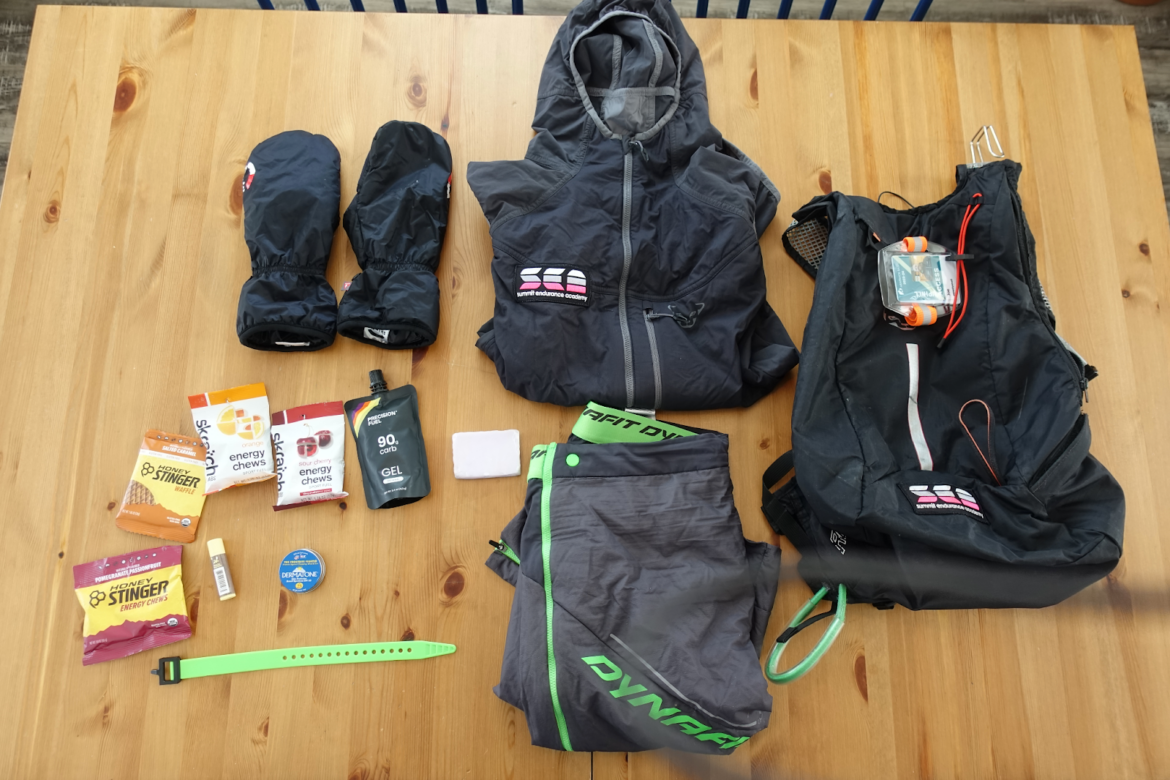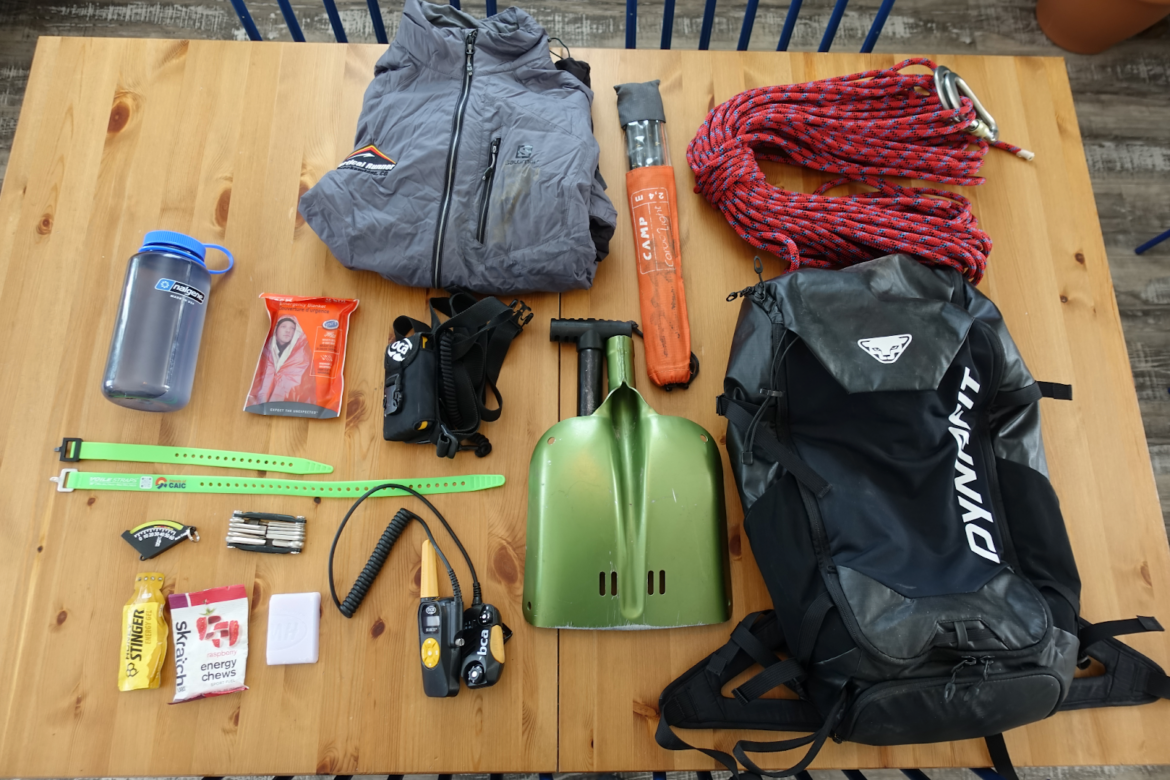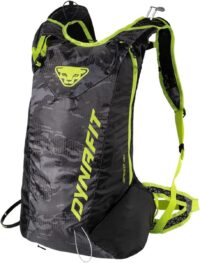The differing styles of all the different ski tourers (tourists? Tourons?) is always interesting to me, running the gamut of the kitchen sink crew who, if needed, could live out of their touring pack in decadent luxury if the need arose, all the way to the ultra weight-weenie minimalist crowd, who carry nothing but the essentials, and hell, sometimes not even those. While most of my life is absolutely more in the weight-weenie crowd, over the years I’ve found a sweet spot for the two main kinds of touring I do: skimo training, and backcountry days with friends.
Editor’s Note: If you want to see a sample packing list for a more mountaineering-oriented tour, check out Teague Holmes’ pack dump here.

What skimo coach/racer Joe Howdyshell carries for his training skis.
Training Packing List:
For a skimo training day, I’m not in avalanche terrain 90% of the time (I try not to combine extreme oxygen debt with critical decision-making), so while I will sometimes do training with a heavier pack, it’s really just adding a hydration bladder and more food to the race pack. For instance, right now I’m training for the Power of Four, so on my long skins I’m taking a couple liters of water and loooots of carbs, which significantly changes the weight of my pack. I don’t worry about how much, I just try to take exactly what I’ll use in the race. It’s about function, not weight.
I’d generally say (coach hat on), unless you’re training for something heavier than your everyday, it’s almost always better to go lighter for training. For the same reason that you wouldn’t train for a running race with giant snow boots, or wouldn’t train for a road bike race on a fat bike, the heavier your gear, the more your legs suffer, and the less your cardiovascular system does. If you were to get in a lab on heavy gear vs light gear, even though your breathing would be hard and your HR would be high, the amount of oxygen you’re taking in and using is far lower on heavy gear than light. Simply put, your muscles get tired before the cardiovascular system gets working. Now there are plenty of reasons to ski big heavy gear, so don’t think I’m saying not to, but if you’re training for something, it’s best to go as light as possible.
Here’s the pack and contents that I use on the average day of either resort laps or low angle touring.
The Pack: My favorite training pack is usually some version of the Dynafit Speed 20. There’s enough room for the basics listed below, and they usually have a good crampon pocket (used almost entirely for snacks, water, and maybe a GoPro), and a really good hook for the ski carry.
Dynafit Mezzalama Vest and Shorts: While I’m not personally a fan of the Mezzalama pants and jacket (they’re simply way too warm for me), I find the vest and shorts an excellent way to add some warmth on chilly days.
Skinfit Schröcken Mittens: My everyday training glove is a Dynafit Mercury DST Glove, which for me is good down to about 10F, except for the first 5-10 minutes where my hands are pretty miserable in almost any temperature. The solution for me is to start most days with the Mercury glove and then the Schröcken mittens over the top for that first 5-10 minutes, when I take them off and stuff them into my pack. If it’s a really cold day, I might leave the mittens on for a while.
Glop Stopper Wax: I put this in my pack in the spring a few years ago and it’s saved my bacon a couple times in the spring.
Ski Straps: The baling wire of the outdoor world, they can fix just about anything.
Handwarmers: Always good to have a pair for days when the hands just won’t warm up.
Some Dermatone and Lip Balm. Again, something that’s saved my bacon a few times when workouts go long, or I get out on the skintrack and realize I forgot to protect my gingerness from the great tanning bed in the sky.
Snacks!: I’m mighty partial to Skratch Labs Energy Chews, Honey Stinger Waffles, and on a particularly high intensity day, some Bare Performance Nutrition gels.
Water/Electrolytes: Contrary to popular opinion, you probably sweat a LOT touring, so I pretty much always have at least a Nalgene with Skratch or Liquid IV.
Phone: Usually buried in the pack so that I can access it for emergencies, but not somewhere I’m tempted to pull it out to check how my latest Instagram post is doing.

What skimo coach/racer Joe Howdyshell carries for his recreational tours with friends.
Touring Packing List:
With the skimo kit described above, I find I can have some pretty good training days and cover most of my needs. Some days though, my goal is much less about fast and light, and more about skiing some rad shit with my friends. Most of these tours are 2-3 hours, 2000’ of climbing, as little mileage as possible. In the winter, usually pow, and then in the spring more line objectives. My whole kit will look quite a bit different on these days. My focus is much more on safety and warmth in all conditions, as I’ll be moving slower and taking more breaks. My daily training pack is pretty consistent, but my backcountry pack will change quite a bit depending on weather, objectives, and partners. Here’s what’s in it from a fairly typical trip last spring:

The Pack: Dynafit Radical 30+. I got this at the end of the season last year and I’m pretty happy with it, but still new to using it. I really like the ski carry, and the back padding, and, man, it fits a lot more than I typically pack!
Beacon: The ol’ standard Tracker3. Love the dependability, and the cool Atari noises are fun.
Probe: Currently a CAMP race carbon probe. Probably the weak point of this particular packing list. I know that a lot of people carry them, and they’re definitely gonna do the job, but I’m personally not sure it’ll do the job twice.
Shovel: An old bulletproof Brooks Range aluminum shovel. Nothing fancy, rock solid and heavy as shit.
An insulating layer: I often tour in unlined hard shells (typically a Dynafit or Salomon hardshell set) so I’ll often just throw a puffy in there for the upper transitions. Current most-packed is a ~12 year old Salomon hoodless synthetic jacket from a now-defunct running store. Doesn’t have to be fancy, folks!
A second pair of gloves: Not pictured in the pack photo, as it was taken for a warmer spring mission, but I almost always carry a second (or two) pairs of the Dynafit DST gloves.
Half-Rope: Probably 8mm, probably 30 meters. Mainly used for rappelling into tight spots, but also other questionable activities. A locking carabiners, because who knows what we’ll get into.
BCA Link 2.0 Radio: Awesome to have good comms out there.
Space blanket: Nothing fancy, just a small insurance policy against shit really hitting the fan.
Inclinometer: I’m pretty good at eyeballing slope angle these days, but I like to calibrate my hunches pretty often.
SNACKS! Nothing ruins a good tour like an aggressive bonk. Compared to a skimo training day, I’m much more likely to pack a sandwich or some cold pizza on a tour, and rely less on the goos/gels/waffles.
Multitool: I actually use a bike tool most days because it works best with my bindings (effing Torx).
Some wax to prevent globbing.
More ski straps: Helpful with gear issues.
Water: Hydrate or die!
Phone: Unlike skimo training, when touring I usually have my phone somewhere I can use it a lot, as I’ll be using the app of the moment for wayfinding and terrain management.
Things I’ll add/take away on other days: The rope is about all I’d take away, but I’d add more gloves, layers, extra skins, different tools, a good camera or GoPro, some handwarmers, a ballcap, maybe a flask of whiskey.
And there you have it! While I certainly skew on the side of light and fast, I also am able to take advantage of fitness to “get away” with some extra weight in the touring pack.
Do your snow dances!

Joe Howdyshell is the Owner and Head Coach of the Summit Endurance Academy, a mountain endurance sports coaching company.
Joe has a masters degree in Exercise Physiology, and has been racing up and down mountains on skis, bikes, and on foot since 1998.
These days Joe lives in Breckenridge, Colorado and coaches and races skimo in the winter, and mountain running and mountain biking in the summer.
Outside of endurance sports and mountain gear, Joe enjoys cooking, reading, and drinking good whiskey with his neighbors.

